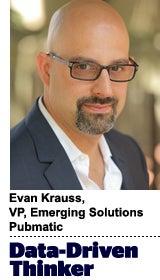 “Data-Driven Thinking” is written by members of the media community and contains fresh ideas on the digital revolution in media.
“Data-Driven Thinking” is written by members of the media community and contains fresh ideas on the digital revolution in media.
Today’s column is written by Evan Krauss, vice president of emerging solutions at PubMatic.
With 160 million people in the US listening to digital audio every day, advertisers’ ears are perking up at the possibilities.
That audience is expected to reach nearly 200 million in the next five years. Consequently, CPMs for audio advertising are on the rise, surpassing display and approaching those of video.
Adoption of programmatic audio, however, is relatively slow because the format stands so far apart from any of its predecessors. Display strategies of catching audiences’ attention visually, for example, won’t work. And audio is also unlike video, where marketers have consumers’ undivided attention.
Audio combines the best of display, which is great for volume because you capture more eyeballs with more ads, and video, which engages users’ senses far beyond display. As advertisers learn to be fluent in this medium, programmatic can supercharge their efforts.
Growing Inventory
The number and variety of digital audio options is growing fast. Spotify and Pandora alone make up about 80% of the available audio inventory today, but that’s just the tip of the iceberg, especially with players like Apple throwing their hat in the ring with new streaming music services. Consumers have their choice of more than 500 “freemium” digital audio options, including natively digital music services, streams of terrestrial radio stations and podcasts. Yet nearly all the inventory on these services is sold directly.
Radio stations have been selling audiences since the beginning. They initially had location and demographic information, before audience measurement services such as Arbitron, a panel-based audience measurement service much like Nielsen is for TV, began providing additional information, including purchase behavior and income levels.
Better Targeting
Now we can leverage the major advances in audience targeting offered by programmatic. The premium nature of most audio content makes it a natural fit for private marketplace solutions, which help surface audiences, improve the level of transparency of publisher inventory and allow for easy inventory bundling and price negotiation between buyers and publishers. Buyers can incorporate audio into their holistic media strategies, tapping into a new way to reach consumers that they weren’t previously reaching. And publishers can use advanced data and analytics to better understand their audience and optimize their yield.
Challenges, Concerns
Audio holds a lot of promise, but we won’t be able to tap into that promise until we address the challenges that face any emerging medium – in particular, cross-device consumer targeting and attribution. The addition of audio to a holistic media strategy, on top of display, mobile, tablet, video, smart TVs, wearables and all manner of yet-to-be-invented screens and devices, creates another layer of complexity in an already complicated media landscape.
In addition, consumers increasingly expect highly customized, seamless advertising experiences across all their devices, and can balk at brands that interrupt their media consumption with intrusive or irrelevant ads. Hands-free audio listeners, who are more engaged than display audiences, for example, will require even better advertising experiences. In order to do that, we have to become more sophisticated in our targeting. With more than 50 billion devices expected to be connected to the Internet in the next decade, the only way to manage this explosion of channels, screens and formats is through smart, real-time technology.
As marketers increasingly tap into the power of sound to capture consumers’ attention, and publishers chase those dollars by incorporating more audio to their offerings, programmatic can give them both the cutting-edge tools they need to thrive.
Follow PubMatic (@PubMatic) and AdExchanger (@adexchanger) on Twitter.













